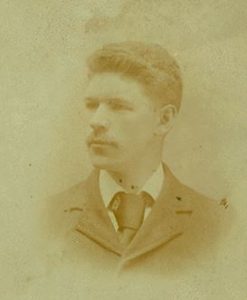
The University of Connecticut’s George Safford Torrey Herbarium was founded by 25-year old Professor Henry Arthur Ballou on December 31, 1897 – although both the university and the herbarium had different names at the time. Ballou was primarily an entomologist, but embraced his role teaching freshman-level botany. Each student was required to assemble an herbarium of 50 specimens, and so the fledgling “Herbarium of Storrs Agricultural College” was born with 121 specimens from the students’ collections. Four years later, Ballou left Storrs Agricultural College to become the Government Entomologist in Barbados.
Edward A. White taught botany for the next five years – the school had by then been renamed the Connecticut Agricultural College – though like Ballou, he was not a trained botanist (his specialties were forestry and landscape architecture). In 1907, the CAC hired Albert Francis Blakeslee as its first dedicated botanist. Blakeslee became a renowned plant geneticist and was an ardent supporter of plant research collections. Blakeslee didn’t collect much in the Storrs area – we have fewer than 50 specimens collected by him locally – but in 1903, he undertook a collecting trip to Venezuela and Haiti to document seaweeds. His specimens from that trip are at Harvard’s Farlow Herbarium (FH), the New York Botanical Garden (NY), the University of Michigan (MICH), and UC-Berkeley (UC).
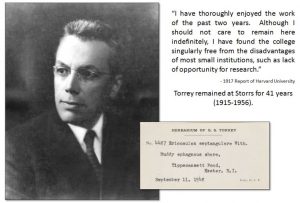
In 1915, Blakeslee left CAC, and the College hired not one, but two botanists: Edmund W. Sinnott and George Safford Torrey. The herbarium collection was still very small: it could fit in two cabinets with room to spare. Perhaps because of this, Sinnott chose to deposit his specimens in prominent herbaria at the Academy of Natural Sciences in Philadelphia (PH) and with the New England Botanical Club, now housed at Harvard University (NEBC). Torrey, on the other hand, set himself to expanding and improving the herbarium right here. Despite joining the Connecticut Agricultural College with no intention of staying beyond a couple of years, Torrey became the longest-serving herbarium curator in our history. After arriving in 1915, he remained for the rest of his career, retiring in 1956.
Torrey began a campaign in the 1940s to increase the herbarium holdings so that the collection could be listed by acronym in Index Herbariorum, thereby firmly establishing the herbarium as a major collection. He began courting local botanist E.H. Eames for his collection of about 30,000 specimens from southern Connecticut in 1940, and the University was bequeathed the collection upon Eames’ death in 1948. Gifts and purchases of other collections added another 10,000 specimens. In less than ten years, Torrey increased the size of the herbarium from 12,663 in 1948 to almost 52,000 specimens. Somehow, he even acquired two specimens collected by Henry David Thoreau from the New England Botanical Club. The Herbarium of the University of Connecticut was finally given an acronym, CONN, in the 1952 edition of Index Herbariorum.

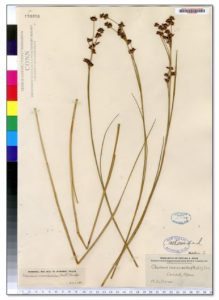
From Torrey’s retirement in 1956 until 1992, there were four directors of the CONN herbarium: Wendell Camp (director 1956 – 1963), Howard Pfeifer (director 1963 – 1987), Robert K. Jansen (director 1987 – 1991), and Kent Holsinger (interim director, 1991 – 1992). Torrey died in the summer of 1977, and in May 1979, the UConn Board of Trustees voted to name the Life Sciences Building (constructed in 1961) in his honor. We suspect that the herbarium was renamed in Torrey’s honor at about this time (it was housed in that building), but have not found documentary evidence to confirm this hypothesis – yet.
1992 was an important year for CONN – the 100,000th specimen was accessioned to the collections, and aquatic botanist Don Les joined the Ecology and Evolutionary Biology faculty and became the director of the herbarium. Les initiated several major developments and oversaw the largest expansion of the herbarium in its history. In 1993, he was at the forefront of the movement to database natural history collections. Progress was initially slow because the collections were crowded into a small facility in the Torrey Life Sciences Building with little work space, just one computer, and no staff dedicated to the task. Les also hired the first full-time collections manager, Les Mehrhoff, in 1996; that same year, the first 1,500 specimens were digitized using Microsoft Access.
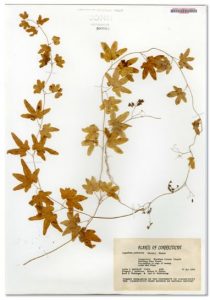

The UConn 2000 plan and support from the National Science Foundation gave the Ecology and Evolutionary Biology Department the opportunity to design and build a state-of-the-art combined Biodiversity Research Collections facility in the BioPhysics Building. Don Les, together with Andrew Doran, (collections manager since 2002) oversaw the massive task of moving the herbarium into the new facility in 2003. The new space has dedicated preparation and storage areas, high-tech fire suppression systems, its own climate control system, and utilizes Integrated Pest Management strategies to minimize the risk of specimen damage due to infestations.
Additional NSF support was awarded to Don Les and Bob Capers (collections manager 2006 – 2017) in the form of a $500,000 grant to digitize the herbarium. More than 50 undergraduate students were trained in various aspects of collections management over the course of the grant, and over 170,000 specimens were databased (using BG-BASE) and imaged at high-resolution. All of these data are available online through our own website as well as various other portals. This gigantic effort uncovered some surprises – a bound herbarium created by Rosa Bolles Watson (the niece of Sereno Watson), and the rediscovery of the two Thoreau specimens acquired by Torrey. We arranged for the Thoreau specimen pictured above to be the 100,000th specimen added to the database.
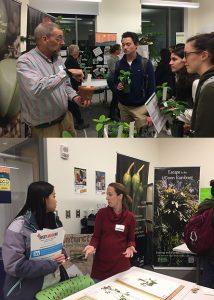
Over the last twenty years, the G.S. Torrey herbarium has continued to grow and change. The number of accessions doubled from 1992 to 2012 and continues to increase. We are approaching our 200,000th databased specimen, and are using new computational tools to analyze the data held in our collections. Some of our work looks the same as it did back in 1897 when Henry Ballou took his students into the field to collect and press plants – we are proud to train students, and we take every opportunity to wander the hills and valleys around campus and beyond, collecting new specimens to bring back to the herbarium and study. Since the retirement of Bob Capers in 2017 and Don Les in 2019, the herbarium has been led by Bernard Goffinet (then interim director) and Sarah Taylor (collections manager). Dr. Karolina Heyduk was appointed as the director in January 2023.
Note: Most of the information in this history was compiled by Don Les for a seminar entitled “Diary of a CONN man – the evolution of research plant collections at the University of Connecticut,” presented on 4 April 2013.